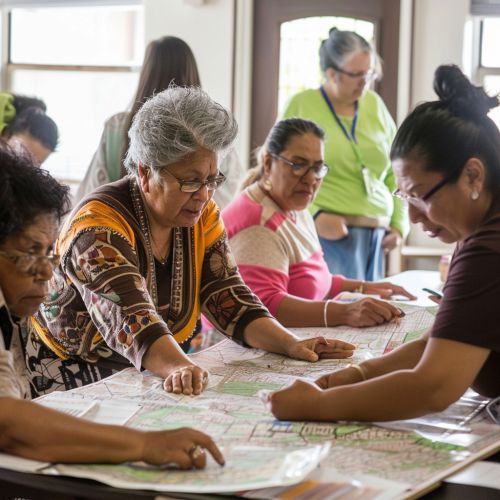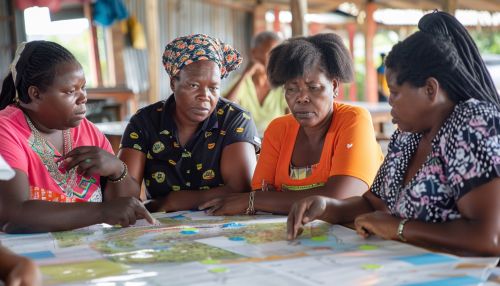Participatory rural appraisal: Difference between revisions
(Created page with "== Introduction == Participatory rural appraisal (PRA) is a methodological approach used in international development and research contexts. It aims to incorporate the knowledge and opinions of rural people in the planning and management of development projects and programs. PRA is a set of participatory and largely visual techniques for assessing group and community resources, identifying and prioritizing problems, and appraising strategies for solving them. The ap...") |
No edit summary |
||
| Line 45: | Line 45: | ||
* **Problem Trees**: Analyzing the root causes and effects of specific problems. | * **Problem Trees**: Analyzing the root causes and effects of specific problems. | ||
[[Image:Detail-91883.jpg|thumb|center|Community members gathered around a table, actively participating in a mapping exercise.|class=only_on_mobile]] | |||
[[Image:Detail-91884.jpg|thumb|center|Community members gathered around a table, actively participating in a mapping exercise.|class=only_on_desktop]] | |||
== Applications of PRA == | == Applications of PRA == | ||
Latest revision as of 05:21, 19 June 2024
Introduction
Participatory rural appraisal (PRA) is a methodological approach used in international development and research contexts. It aims to incorporate the knowledge and opinions of rural people in the planning and management of development projects and programs. PRA is a set of participatory and largely visual techniques for assessing group and community resources, identifying and prioritizing problems, and appraising strategies for solving them. The approach emphasizes local knowledge and enables local people to make their own appraisal, analysis, and plans.
Historical Background
The roots of PRA can be traced back to the 1970s and 1980s, when development practitioners began to recognize the limitations of top-down approaches to rural development. Traditional methods often failed to capture the complexities of rural life and overlooked the valuable insights of local communities. The development of PRA was influenced by earlier participatory methods such as Rapid Rural Appraisal (RRA) and Participatory Action Research (PAR). PRA evolved as a more inclusive and empowering approach, emphasizing the active involvement of local people in the research and planning process.
Principles of PRA
PRA is guided by several core principles that distinguish it from other research and planning methodologies:
- **Participation**: Local people are actively involved in the entire process, from data collection to analysis and decision-making.
- **Flexibility**: PRA methods are adaptable to different contexts and can be modified based on the specific needs and conditions of the community.
- **Teamwork**: PRA is typically conducted by a multidisciplinary team, including local facilitators and external experts.
- **Optimal Ignorance**: The focus is on gathering only the most relevant information, avoiding unnecessary data collection.
- **Triangulation**: Multiple methods and sources are used to cross-check and validate information.
- **Learning and Empowerment**: PRA aims to enhance the capacity of local people to analyze their own situation and take action.
Methods and Tools
PRA employs a variety of participatory tools and techniques, which can be broadly categorized into the following groups:
Mapping and Modeling
- **Social Mapping**: Creating visual representations of the community, including households, infrastructure, and resources.
- **Resource Mapping**: Identifying and mapping natural resources such as water sources, forests, and agricultural land.
- **Transect Walks**: Systematic walks through the community to observe and discuss various aspects of the local environment.
Ranking and Scoring
- **Preference Ranking**: Ranking different options or preferences based on criteria defined by the community.
- **Wealth Ranking**: Categorizing households or individuals based on their relative wealth or socio-economic status.
- **Matrix Scoring**: Comparing and scoring different options or scenarios using a matrix format.
Seasonal Calendars and Timelines
- **Seasonal Calendars**: Charting seasonal variations in activities, resources, and issues such as agriculture, labor, and health.
- **Historical Timelines**: Documenting significant events and changes in the community over time.
Diagramming and Visualization
- **Venn Diagrams**: Illustrating relationships and interactions between different groups, institutions, or factors.
- **Flow Diagrams**: Mapping out processes, systems, or causal relationships.
- **Problem Trees**: Analyzing the root causes and effects of specific problems.


Applications of PRA
PRA has been widely used in various sectors and contexts, including:
- **Agriculture and Natural Resource Management**: Engaging farmers and rural communities in the planning and management of agricultural projects, conservation efforts, and sustainable resource use.
- **Health and Nutrition**: Involving local people in identifying health issues, designing interventions, and monitoring health programs.
- **Education and Training**: Developing community-based education programs and training initiatives that reflect local needs and knowledge.
- **Disaster Risk Reduction**: Assessing vulnerabilities and capacities, and planning for disaster preparedness and response.
- **Gender and Social Inclusion**: Addressing issues of gender inequality and social exclusion by involving marginalized groups in the decision-making process.
Challenges and Criticisms
While PRA has many strengths, it also faces several challenges and criticisms:
- **Power Dynamics**: Ensuring genuine participation and avoiding the dominance of more powerful individuals or groups can be difficult.
- **Quality and Reliability of Data**: The participatory nature of PRA can sometimes lead to biases or inaccuracies in the data collected.
- **Sustainability**: Maintaining the momentum and ensuring the long-term sustainability of PRA initiatives can be challenging.
- **Capacity Building**: Effective PRA requires skilled facilitators and adequate training, which may not always be available.
Conclusion
Participatory rural appraisal is a valuable approach for involving rural communities in the planning and management of development projects. By emphasizing local knowledge and active participation, PRA can lead to more relevant, effective, and sustainable outcomes. However, it is important to be aware of the challenges and limitations of PRA and to continuously strive for improvements in practice.
See Also
- Rapid Rural Appraisal
- Participatory Action Research
- Community Development
- Sustainable Development
- Empowerment
